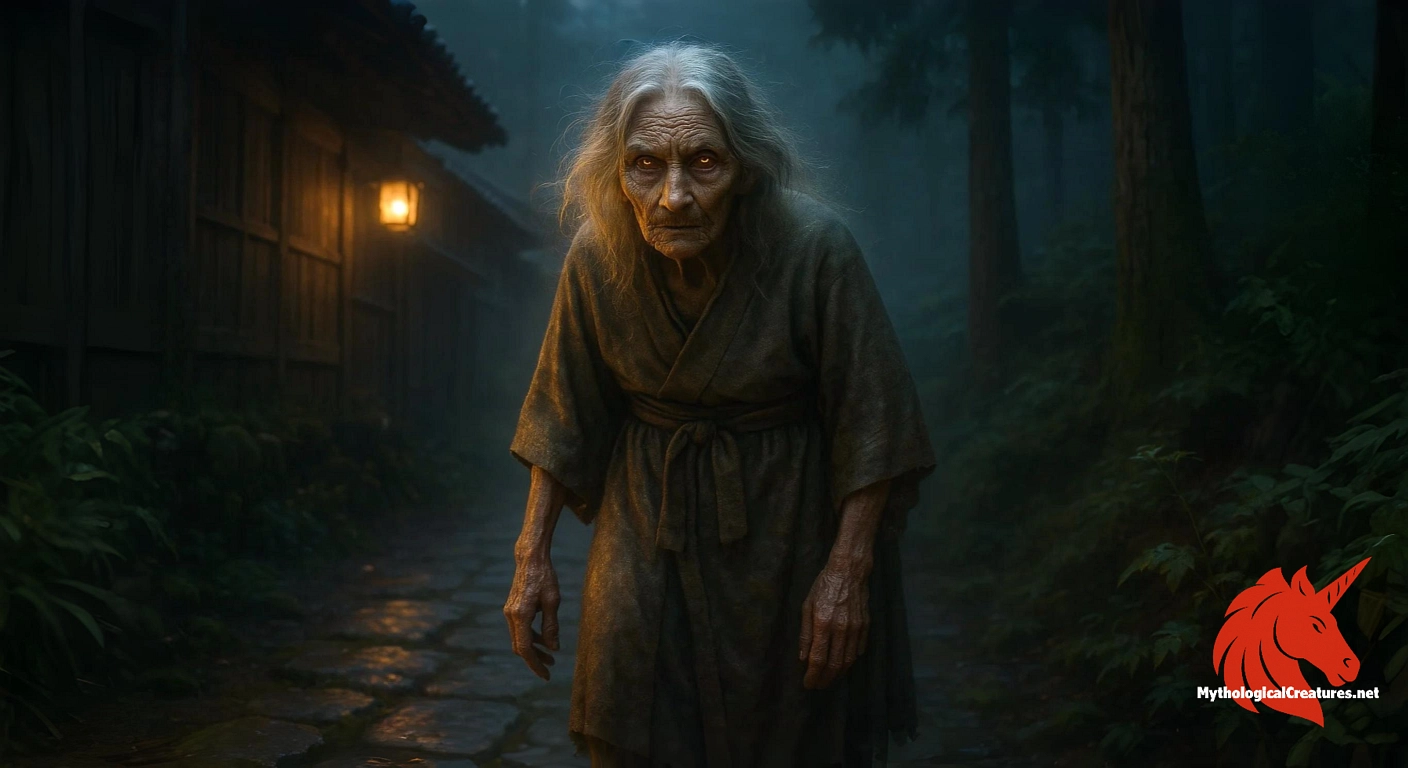Amazake-babaa: Amazake-babaa is an old woman yōkai from the folklore of northern Japan, known for her nocturnal visits asking for amazake.

Amazake-babaa
Amazake-babaa - Represents the dual nature of disease deities in Japan, serving both as a curse-inducing entity and as a protective figure when properly appeased.
Origins & First Encounters
Amazake-babaa is a mysterious figure deeply embedded in the folklore of northern Japan, where her nocturnal appearances stirred both dread and cautious reverence. Her origins can be traced to a time when epidemics such as smallpox ravaged communities, and local legends grew to explain the inexplicable spread of illness. Documented in the oral traditions of Miyagi and Aomori prefectures, her tale has circulated as a cautionary narrative linking the everyday with the supernatural. She is said to approach households at night, her voice possessing an unsettling, childlike quality that belies the grim consequences of her visit. The duality of her character, as both a potential harbinger of disease and a protective force when properly appeased, reflects the complex interplay between fear and hope in times of crisis. Her story provided a framework for communities to rationalise the devastation wrought by epidemics while offering rituals to stave off misfortune. Community practices, such as the placement of cedar branches and the offering of simple sweets like amazake, underscore the practical measures entwined with her myth. Ultimately, Amazake-babaa remains a fascinating embodiment of how folklore can transform natural calamities into narratives of both warning and salvation.
Source Texts & Tale Variants
The legends surrounding Amazake-babaa are preserved through a rich tapestry of oral narratives and regional folktale compilations. Local storytellers in Miyagi and Aomori have long recounted her enigmatic visits that warn of impending bouts of illness. Early manuscripts and temple records in these regions subtly reference her as a spectral figure intertwined with the mysteries of smallpox. As her tale spread, variations emerged that detailed her method of soliciting amazake at doorsteps, a motif that has persisted over generations. Some accounts even blend her identity with that of a deified human, reflecting the fluid boundaries between mortal and supernatural in Japanese folklore. The diversity of narratives—from door-to-door visits to her unexpected transformation into a benevolent protector—has enriched her mythos. Over time, her story has been collected in regional anthologies, ensuring its transmission even as oral traditions fade. These layers of source material highlight the evolving nature of myth-making, where each retelling contributes to the enduring legacy of Amazake-babaa.
Form & Powers
Descriptions of Amazake-babaa, though sparse, evoke the image of an ancient crone whose physical presence oscillates between frailty and latent menace. Her visage is often depicted as time-worn, with deep creases and weathered skin that tell the story of many harsh winters and relentless epidemics. Traditional portrayals emphasise her unkempt, silver-white hair cascading in tangled strands, offering a spectral glow under the faint light of dusk. The contours of her face, marked by piercing, almost otherworldly eyes and a crooked smile, contribute to the eerie impression she leaves on those who see her. Her garments, usually portrayed as simple and time-honoured, resonate with the rustic aesthetics of historical Japan and the simplicity of rural life. Despite the apparent frailty in her physical form, there is an unmistakable intensity in her gaze that hints at her inherent supernatural energy. Some regional accounts suggest that her form can subtly shift—oscillating between that of a benign elderly woman and a more menacing, ghostly figure. Such variations in her depiction have enchanted artists and storytellers alike, ensuring that her image remains as enigmatic as the myths she inspires.
Regional Faces
The tale of Amazake-babaa is replete with regional variations that illustrate the adaptability of folklore across different cultural landscapes. In Miyagi and Aomori, she is primarily portrayed as a spectral old woman whose late-night visits portend the arrival of smallpox or other ailments. Here, the emphasis is on her unexpected knock at the door and the simple request for amazake, which cleverly masks her ominous influence. In contrast, the variant known as amazake-banbaa found in Yamanashi Prefecture adopts a distinctly commercial aspect, actively attempting to sell her beverages door-to-door. This version underlines a fascinating intersection between superstition and everyday commerce. In urban quarters like the Kohinata neighbourhood of Bunkyo City, the legend takes on a unique twist where Amazake-babaa is reimagined as a once-mortal local amazake-seller who was deified after her premature death. Such transformations highlight how local communities recalibrate folklore to address contemporary anxieties and social experiences. Each regional adaptation reflects particular local customs, environmental challenges, and collective memories, ensuring that her myth remains a living and evolving tradition.
Cultural Parallels
The enigmatic character of Amazake-babaa resonates with figures found in various mythologies around the world, creating intriguing cross-cultural parallels. Her ambiguous role as both a potential bringer of disease and a guardian against it bears similarities to Baba Yaga in Slavic folklore, where old age and mystical power coexist in a figure who is as unpredictable as she is revered. Like many such mythological crones, Amazake-babaa blurs the lines between benevolence and malevolence, acting as both a protector and a cautionary emblem. Her nocturnal, door-to-door visits evoke the universal theme of threshold entities that challenge the safety of the domestic sphere. In other East Asian traditions, spirits and deities linked with illness share a similar duality, embodying the community’s efforts to rationalise and combat widespread contagions. The commercial spin found in her variant from Yamanashi introduces an additional layer reminiscent of trickster figures who use commerce as a guise for supernatural mischief. This blend of nurturing and punitive qualities is a common motif in folklore, reflecting society’s ambivalence towards external forces that impact health and wellbeing. Such cultural intersections underscore the shared human need to understand and symbolise the mysteries of life, death, and the passage of disease through myth. Amazake-babaa, in this light, becomes a mirror reflecting broader narrative traditions, where regional specificity meets universal archetypes.
Legacy & Modern Evolution
Amazake-babaa’s evolution over time mirrors the shifting cultural attitudes towards disease and the supernatural in Japan. Once feared as the incarnate goddess of smallpox during an era when epidemics decimated populations, her story served both as a warning and a template for communal healing rituals. The traditional practice of leaving cedar branches at doorways and crafting signs to repel her has endured as a symbolic gesture against illness and misfortune. Over the centuries, her myth has transformed from a mere harbinger of disease into a revered emblem of protective power, especially in communities seeking to safeguard their children. Modern reinterpretations have embraced her ambiguous character, blending elements of historical reverence with contemporary artistic expression. In urban settings like Bunkyo City, she is celebrated through public installations and local lore that honour her legacy as a deified local figure. Scholars and artists alike have found in her a rich source of inspiration, symbolising the human capacity to adapt and reframe even the most fearsome aspects of the past. Ceremonies and cultural festivals occasionally invoke her memory, serving as a bridge between ancient superstitions and modern public health consciousness. Her enduring presence in folklore underscores the timeless dialogue between human vulnerability and the quest for resilience. Ultimately, Amazake-babaa remains a compelling reminder of how myth can transform calamity into a narrative of hope and communal identity.
Interesting Fact
Amazake-babaa's transformation from a feared curse-bringer to a deified protector illustrates the dynamic evolution of folklore in response to changing societal needs and interpretations.
Quick Creature Info
Associations:
Our Mythic Legendary Rating:

Also Sometimes Known As:
Habitat:
Supernatural Powers:
Physical Attributes:
Abilities:
Behavior:
Weaknesses:
Lore:
Related Creatures, Tales or Lore
- BBaba Yaga
- YYamauba
- AAmazake-banbaa
References
Discover Another Mythical Legend You May Not Have Heard Of?
Uncover the mysteries of ancient folklore and expand your knowledge of legendary beings from cultures around the world.
Dare to Meet the Sequana....
Mythical Disclaimer: The images and data on this site are derived from various historical and literary sources, but we have found that many myths often have multiple versions and interpretations across references, sometimes contradictory. As a result, these creature depictions are artistic interpretations—imaginative blends of folklore, legend, and a dash of AI guesswork. Because creature descriptions vary widely, our illustrations and accompanying information represent our best effort to honor mythology while bridging creative gaps. Enjoy these interpretations—just remember, we've done our best to respect the stories and validate available data, but in the realm of mythology, details often shift, imagination leads the way, and nothing is ever set in stone!
Curated by the Mythological Creatures Team (rev. May 2025)
